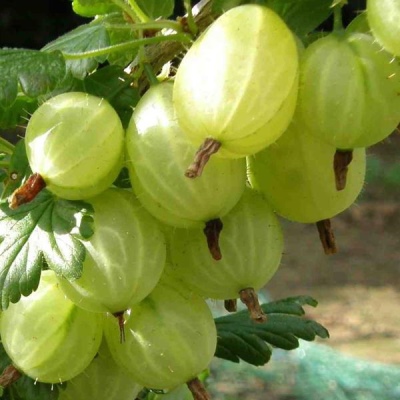
- Name synonyms: Ribes uva-crispa Shalun
- Growth type: medium-sized
- Description of the bush: slightly spreading, compact
- Escapes: medium thickness, well leafy
- Berry size: large
- Berry weight, g: 4-5
- Berry shape: rounded
- Berry color: yellow-green with lighter venation
- Skin : thin, without pubescence, with a slight waxy coating, transparent
- Taste: sweet, with moderate acidity and light spice
It is difficult to find people who would not imagine what pranks are. However, unlike the noisy and flushed toddler, the Shalun gooseberry is a very serious culture. And therefore, you need to very carefully study all its features before disembarking, so as not to run into problems.
Description of the variety
Shalun has an official synonym - Ribes uva-crispa Shalun. The medium-sized bushes of this gooseberry are moderately spreading. They develop rather compactly. The height of the shrub reaches 1 m, and, which is very pleasant for gardeners, there are no thorns. A large number of leaves develop on moderately thick shoots.
Characteristics of berries
It is like this:
large fruits are typical;
1 berry weighs on average 4-5 g;
the fruit is characterized by a rounded shape;
predominantly yellow-green color with lighter veins than the main part.
Taste qualities
Shalun's pulp is very juicy, which will delight even experienced gourmets. The taste is dominated by a sweet note. But at the same time there is also a light, not aggravating impression, sourness and slightly pronounced spice. A fresh, delicate aroma is noted. In general, the berries of this variety were given a tasting score of 4.9 points (that is, an almost ideal verdict).
Ripening and fruiting
Shalun is a typical gooseberry, medium in terms of ripening. Fruit picking begins approximately at the end of July. Of course, this period can be seriously affected by the weather and the way farmers take care of the plants.
Yield
The variety cannot boast of special productivity. It is approximately at the middle level. The usual collection reaches 4 kg per 1 bush. Remarkably, the harvested crop is distinguished by good commercial characteristics. It is not difficult to transport it over a long distance.
Landing
For such a gooseberry, you need a nutritious, loose soil. Moisture permeability should be high, but excessive moisture is best avoided. The cultivar can grow both in the sun and in partially shaded areas. Sun-drenched places should be preferred whenever possible. Areas to the south and southwest of capital buildings are especially good.

Growing and care
Gooseberry Shalun is self-fertile. Therefore, it can be cultivated even in isolation from other bushes. Most often, such a variety is planted in the spring, before the buds bloom. At the stage of active cultivation, systematic watering and loosening of the land are very important. Since the gooseberry tolerates even dry periods well, they are usually limited to three waterings during the growing season:
when shoots are actively developing;
when flowering;
when the fruits formed on the branches ripen.
The earliest feeding should anticipate the dissolution of the buds. At this moment, 1 sq. m lay 30 g of carbamide and 15 g of nitrate. Before flowering, wood ash and potassium sulfate are used. During the ripening period of berries, it is necessary to prepare an infusion on potato peel.In mid-October, the soil in the area of the Shalun trunk is mulched, applying per 1 m2:
compost (6 kg);
superphosphate (15 g);
potassium sulfate (25 g).
Immediately after planting, 3 or 4 of the strongest shoots are left on the bushes. They are cut strictly to 4 buds. In the second year of development, you can already leave 7 well-formed shoots. They are pruned at a height of 30 cm above the ground. Other shoots are supposed to be cut at a level of 20 cm.
Slices should be done at an angle of 50 degrees. They retreat upward from the kidneys by at least 5 mm. In the third year of development, they necessarily get rid of the growth that develops in a horizontal direction. Before the onset of winter, it is necessary to clear the area from the litter accumulated on it, and then dig the ground 30 cm deep. The bending of the bushes to the ground is achieved using steel or wooden staples.



Disease and pest resistance
The cultivar's official description insists that the cultivar does well with American powdery mildew. In this case, it is necessary to take into account the high probability of aphid damage. Only proper treatment with special preparations helps to protect the bushes from its invasion. In conditions of heavy heavy rains, it is likely to be affected by anthracnose or white spot. Prevention measures for these pathologies are the same as usual.

In order for the gooseberry to produce a good harvest, it is necessary to devote time to disease prevention.
Resistance to adverse climatic conditions
The mischievous person is able to survive a rather harsh winter. It is allowed to grow in areas with a difficult climate. In unofficial materials, it is emphasized that this variety also resists drought well. However, it is not very reasonable to abuse this property and refuse intensified watering in hot weather.

Review overview
In the assessments of ordinary gardeners, most of all, the absence of thorns on the branches attracts attention. Harvesting is possible during each growing season, without interruption. Summer residents also speak favorably about the resistance of this variety to winter conditions. The berries are big and tasty, they live up to all expectations.



































































